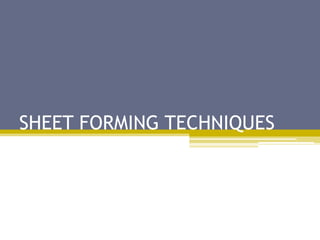
Sheet Forming Techniques for High SA:thickness Parts
- 2. INTRODUCTION High SA:thickness ratio. But plates also used. E.g. metal desks, appliance bodies, aircraft panels, beverage cans, car bodies, kitchen utensils. Sheet forming also called press working. Producing a blank from a sheet. shearing
- 4. INTRODUCTION The thickness or lateral dimensions of the work piece are intentionally changed in bulk deformation. In sheet-forming any changes in thickness is due to stretching of sheet under tensile stresses (Poisson’s Effect). Thickness decreases should generally be avoided as they lead to necking & failure.
- 5. FACTORS Sheet forming involves bending & stretching. Therefore some properties have to be taken care of: Elongation Yield-point elongation Anisotropy Grain size Residual stresses Spring back Wrinkling
- 6. YIELD POINT ELONGATION Low-Carbon steels exhibit yield point elongation of the order of a few %. This means that when the material yields, it stretches further in certain regions in the specimen. Lueder’s bands/stretcher strains/worms are produced. These are elongated depressions on the surface of the specimen. Objectionable on final part, difficult for coating operations 0.5%-1.5% temper rolling/skin rolling
- 7. RESIDUAL STRESSES Residual stresses are stresses that remain after the original cause of the stresses (external forces, heat gradient) has been removed. Present in sheet metals parts due to non-uniform deformation of the sheet during forming. By removing a part of it, the part may distort. Tensile residual stresses may also cause SCC. Spring back may occur in metal parts. Difference in stresses. Over bending. Stretch bending.
- 9. GAUGE The thickness of the sheet metal is called its gauge. The gauge of sheet metal ranges from 30 gauge to about 8 gauge. The higher the gauge, the thinner the metal is.
- 10. BENDABILITY R/T ratio. The difference between inner & outer strains increases if R/T ratio decreases i.e. sharper bends. Minimum bend radius is expressed in terms of thickness T. this is the radius at which a crack will appear on the outer surface. Bendability also depends on edge conditions. Anisotropy of sheet metal is important in bendability. Cutting the blank in proper direction.
- 11. BENDING OPERATIONS Free-bending, where there is only one die. Rolls are also used to bend sheets. In air bending's truest form, the material touches the tools at only three points. used for forming thick gauges (10 gauge and thicker) Beading is where the edge of the sheet metal can be into the cavity of a die. Sharp edges are removed & the overall part becomes stiff. Flanging: is a process of bending the edges at 900 (types of flanges in sheet) Roll Forming is used for bending continuous lengths of sheets by passing the sheet through a series of rolls. Typical products include gutters, channels, panels, frames etc. Thicknesses used range from about 0.125mm-20mm.
- 12. PRESS BRAKE
- 13. BENDING OPERATIONS-TUBES Press-Brake Forming: used with metal parts at least 7m in length & relatively narrow. Dies in mechanical & hydraulic press. Bottoming: there is no air between the punch, material being formed, and the die. The material will be bent to 90 degrees at the bottom. Bottoming as defined will not produce an accurate bend. Spring back. Bottoming With Penetration (Coining).
- 15. DEEP DRAWING A flat sheet metal blank is formed into a cylinder or box-shaped part by means of a punch that presses the blank in to the die cavity. Typical parts produced are: beverage cans, pots & pans, containers, sinks etc. STRETCHING & pure drawing both take place. High blank holder force can cause stretching. This leads to stretching & necking. Low blank holder force. Only blank diameter is decreased as drawing progresses.
- 16. DEEP DRAWING If the sheet thickness is more than the clearance between the punch & the die, the thickness will have to be reduced. This effect is known as ironing. Ironing produces cups with constant wall thickness. Longer cups are also produced. Clearance between the punch & die are usually maintained at 7-14% more than the original thickness of sheet. Wall thickness of cup. Corner radii of punch & die. Too small causes fractures at corners. Too big causes wrinkling.
- 17. SHEARING MECHANISM A punch & a die. Major variables are: punch force, punch speed, lubrication, surface condition, & materials used for punch & die. Slug & a sheet Clearance ;Burr; Burr Height; Burr height increases with increasing clearance & increasing ductility. Tools with dull edges are also a major factor in burr formation.
- 18. SHEARING Punching/Piercing Blanking Perforating Slitting Parting Notching Lancing Nibbling